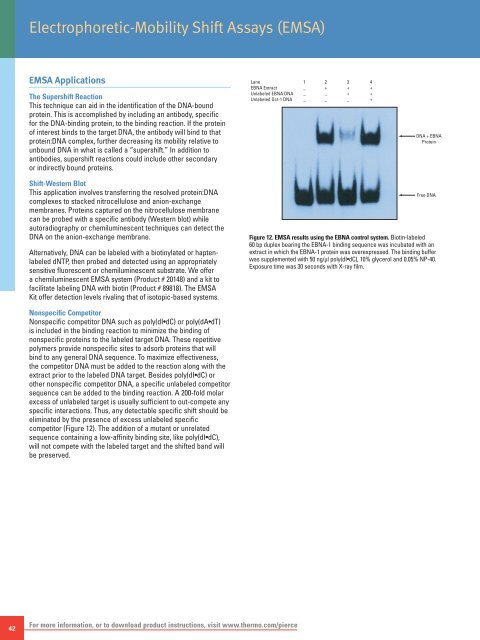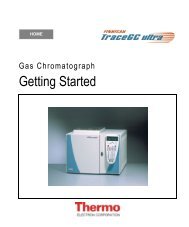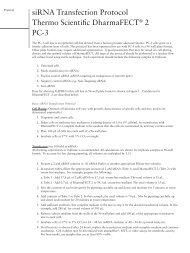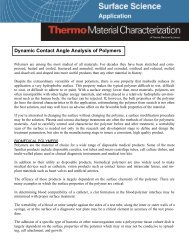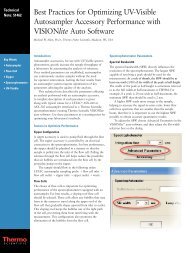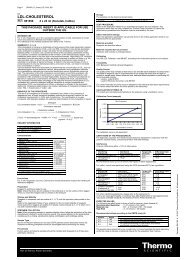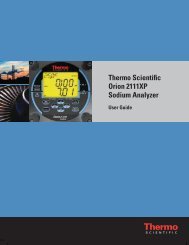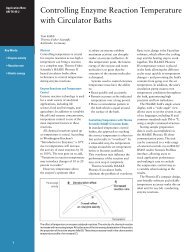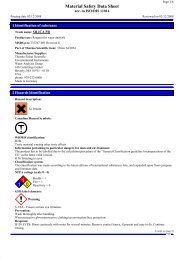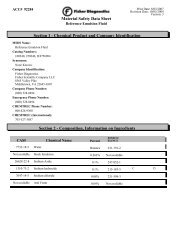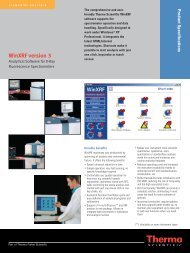Thermo Scientific Pierce Protein Interaction Technical Handbook
Thermo Scientific Pierce Protein Interaction Technical Handbook
Thermo Scientific Pierce Protein Interaction Technical Handbook
You also want an ePaper? Increase the reach of your titles
YUMPU automatically turns print PDFs into web optimized ePapers that Google loves.
Electrophoretic-Mobility Shift Assays (EMSA)<br />
EMSA Applications<br />
The Supershift Reaction<br />
This technique can aid in the identification of the DNA-bound<br />
protein. This is accomplished by including an antibody, specific<br />
for the DNA-binding protein, to the binding reaction. If the protein<br />
of interest binds to the target DNA, the antibody will bind to that<br />
protein:DNA complex, further decreasing its mobility relative to<br />
unbound DNA in what is called a “supershift.” In addition to<br />
antibodies, supershift reactions could include other secondary<br />
or indirectly bound proteins.<br />
Lane 1 2 3 4<br />
EBNA Extract _ + + +<br />
Unlabeled EBNA DNA _ _ + +<br />
Unlabeled Oct-1 DNA _ _ _ +<br />
DNA + EBNA<br />
<strong>Protein</strong><br />
Shift-Western Blot<br />
This application involves transferring the resolved protein:DNA<br />
complexes to stacked nitrocellulose and anion-exchange<br />
membranes. <strong>Protein</strong>s captured on the nitrocellulose membrane<br />
can be probed with a specific antibody (Western blot) while<br />
autoradiography or chemiluminescent techniques can detect the<br />
DNA on the anion-exchange membrane.<br />
Alternatively, DNA can be labeled with a biotinylated or haptenlabeled<br />
dNTP, then probed and detected using an appropriately<br />
sensitive fluorescent or chemiluminescent substrate. We offer<br />
a chemiluminescent EMSA system (Product # 20148) and a kit to<br />
facilitate labeling DNA with biotin (Product # 89818). The EMSA<br />
Kit offer detection levels rivaling that of isotopic-based systems.<br />
Free DNA<br />
Figure 12. EMSA results using the EBNA control system. Biotin-labeled<br />
60 bp duplex bearing the EBNA-1 binding sequence was incubated with an<br />
extract in which the EBNA-1 protein was overexpressed. The binding buffer<br />
was supplemented with 50 ng/µl poly(dI•dC), 10% glycerol and 0.05% NP-40.<br />
Exposure time was 30 seconds with X-ray film.<br />
Nonspecific Competitor<br />
Nonspecific competitor DNA such as poly(dI•dC) or poly(dA•dT)<br />
is included in the binding reaction to minimize the binding of<br />
nonspecific proteins to the labeled target DNA. These repetitive<br />
polymers provide nonspecific sites to adsorb proteins that will<br />
bind to any general DNA sequence. To maximize effectiveness,<br />
the competitor DNA must be added to the reaction along with the<br />
extract prior to the labeled DNA target. Besides poly(dI•dC) or<br />
other nonspecific competitor DNA, a specific unlabeled competitor<br />
sequence can be added to the binding reaction. A 200-fold molar<br />
excess of unlabeled target is usually sufficient to out-compete any<br />
specific interactions. Thus, any detectable specific shift should be<br />
eliminated by the presence of excess unlabeled specific<br />
competitor (Figure 12). The addition of a mutant or unrelated<br />
sequence containing a low-affinity binding site, like poly(dI•dC),<br />
will not compete with the labeled target and the shifted band will<br />
be preserved.<br />
42<br />
For more information, or to download product instructions, visit www.thermo.com/pierce


